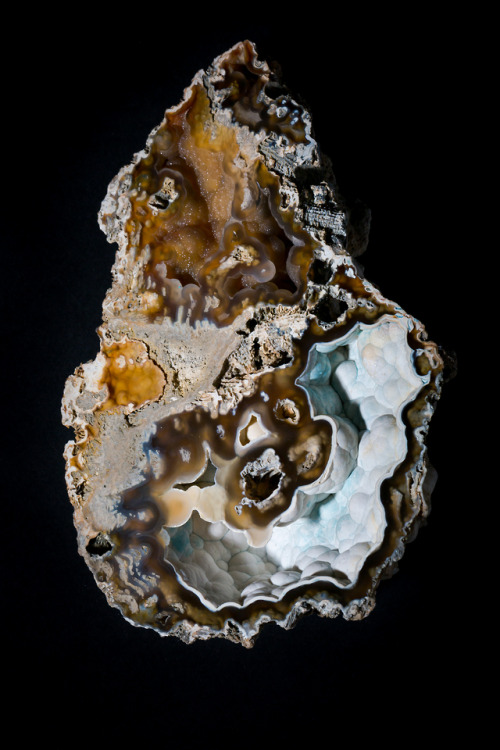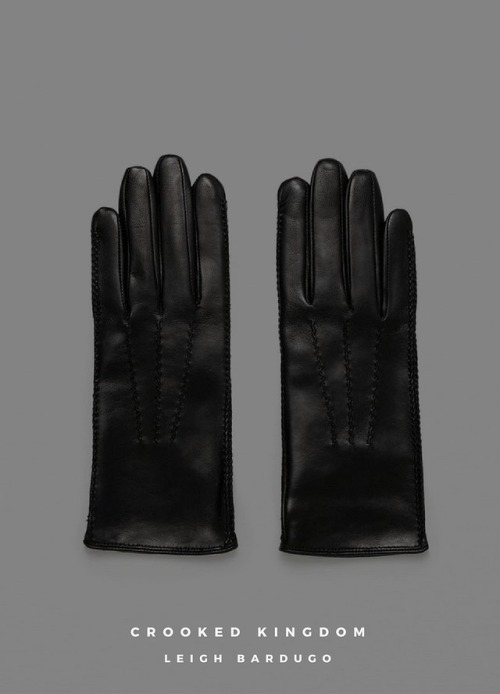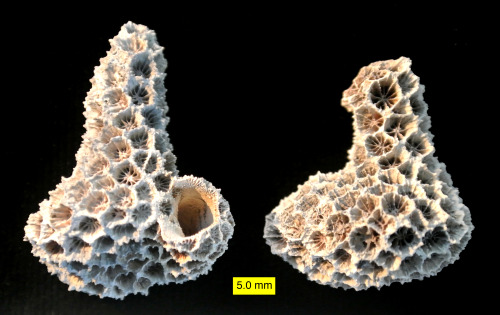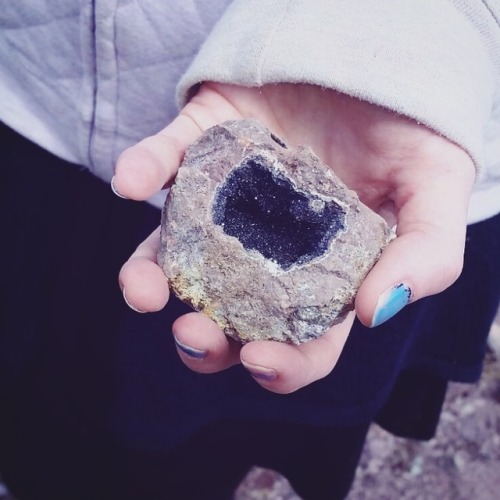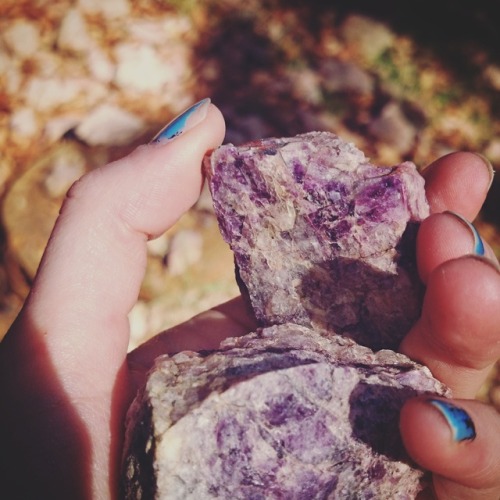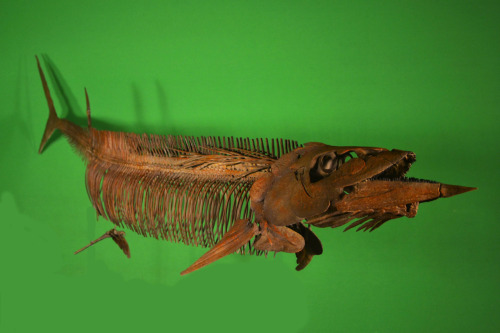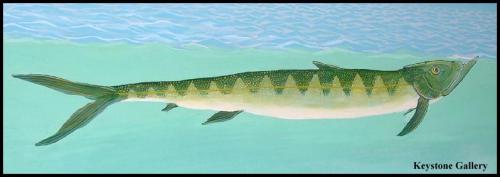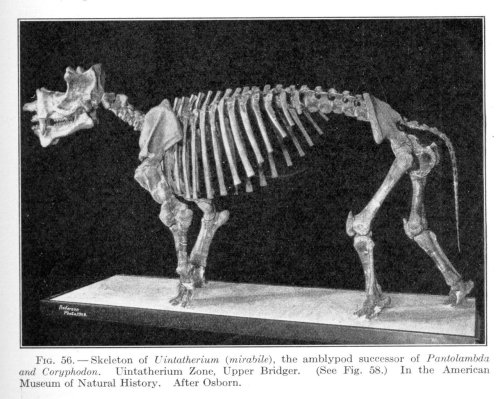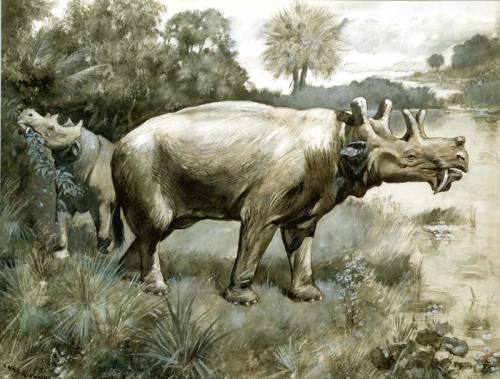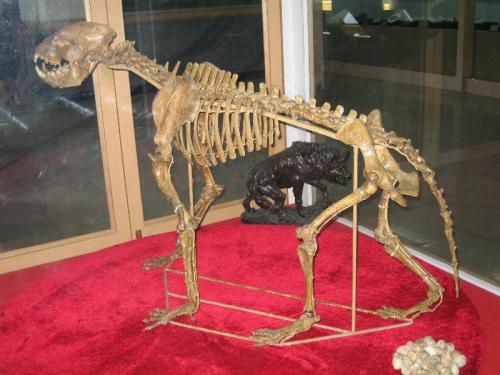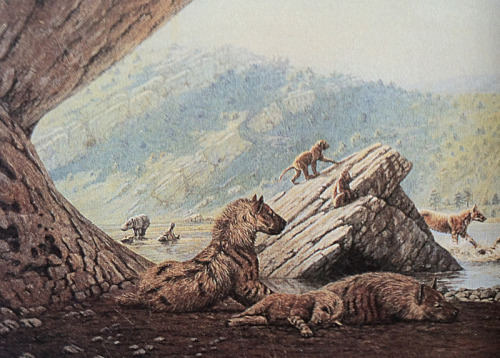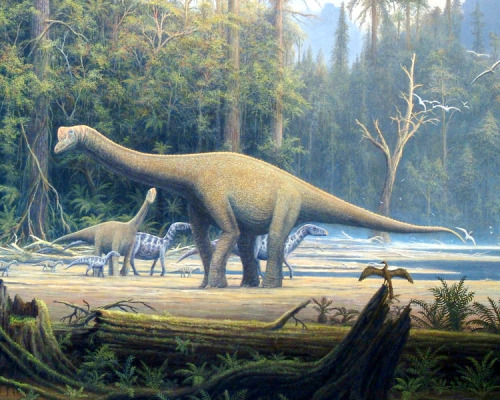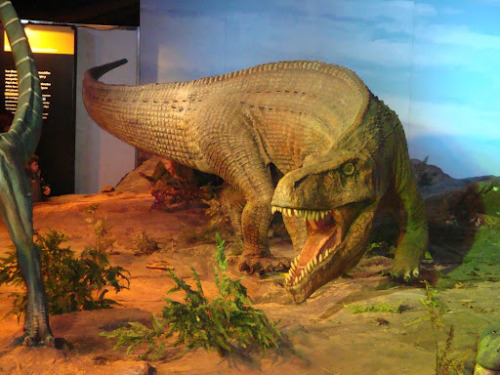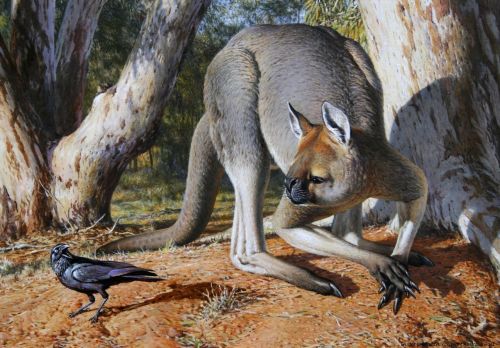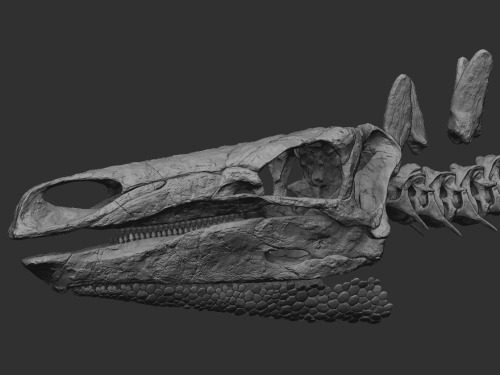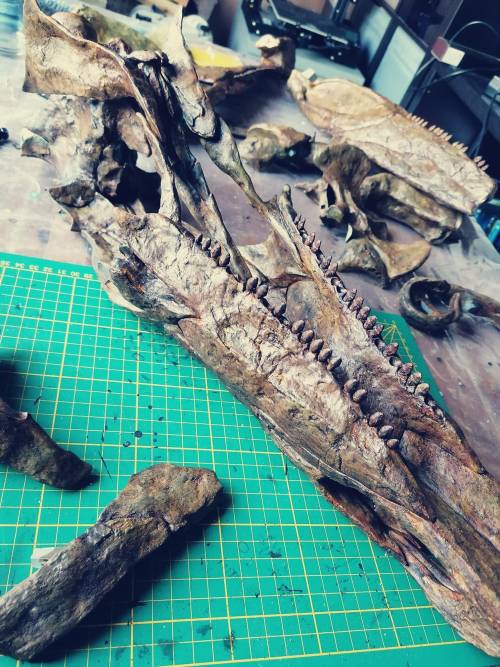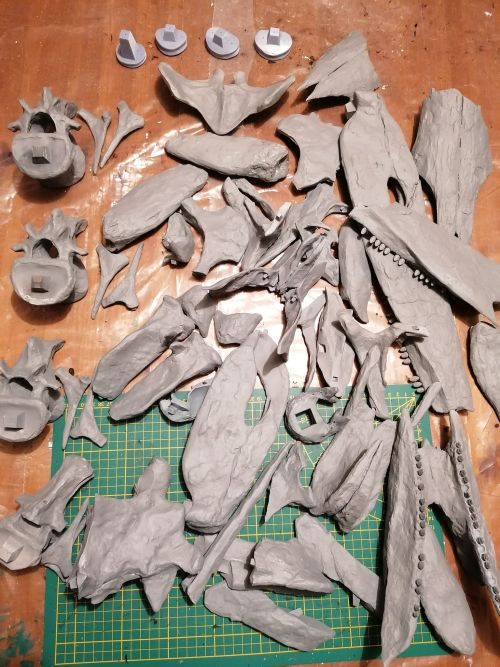#fossil
Agatized coral
Scientific name: Quartz after coral (Coral fossils that have “filled in” with quartz/chalcedony)
Locality: Florida
Age: Miocene
Department:Invertebrate Zoology & Geology, image © California Academy of Sciences
Post link
Cotylorhynchus
Fossil specimen on display at the American Museum of Natural History
Reconstruction by Hirokazu Tokugawa
When: Permian (~299 to 265 million years ago)
Where: North America
What: Cotylorhynchus is a member of one of the most basal groups of synapsids, the Caseidae. Cotylorhynchus was a herbivore, and reached lengths of up to 20 feet (~6 meters) long, with a massive barrel chest, putting weight estimates at around 2 tons. This animal is very large for its time… well at least its body is. Cotylorhynchus has one of the most extreme cases of ‘tiny head’ I have ever seen. Even more so than the sail-backed Edaphaosaurus! Which is closer to modern mammals than Cotylorhynchus is. It is one of the most primitive animals known that unambiguously falls on the synapsid lineage. It is so basal that it does not even have any differentiation seen in its dentition, though there are less teeth than found in the non synapsid contemporaries of this wee-headed creature.
Post link
Saurodon - a sword eel
Mounted reconstruction on display at the Rocky Mountain Dinosaur Resource Center, Woodland Park, Colorado
Reconstruction by Charles Bonner
When: Cretaceous (~ 89 - 83 million years ago)
Where: North America
What:Saurodon is one of the large fish which swam though the Cretaceous Seaway, the marine waters that covered much of North America during the late Mesozoic. This particular species was ‘only’ about 8.5 feet (~2.6 meters) long, with a relatively skinny body and large pointed lower jaw. These features are what gives the family Saurodontidae the nick-name 'sword eels’. The Saurodontidae fall into the later group Ichthyodectidae, a completely extinct clade that contains some of the largest fish on record. Today the living relatives of these gigantic fishes are in the clade Osteoglossomorpha and are some of the largest bony fish that swim though today’s waters.
This was not a very specious group - there are only three described species - but they have been known to science for almost two-hundred years. The first Saurodontidaewas named in 1824 by Richard Harlan (the discover of Harlan’s ground sloth) - but was misidentified as the jaw of an extinct marine reptile. This was corrected only six years later when the first Saurodon specimen was found, and it was clear that the fragmentary specimen which was previously named belonged to a large fish, not a marine reptile. The use of the long lower jaw in Saurodon and its kin is not well understood, but it has been hypothesized that perhaps these predatory fish dug prey out from the deep muds at the bottom of the seaway.
Post link
Uintatherium
Mounted specimen from American Museum of Natural History, and currently part of the traveling Extreme Mammals exhibit.
Reconstruction by Charles Knight
When: Eocene (~49 to 39 million years ago)
Where: North America
What:Uintatherium is one of the first large mammalian herbivores. It stood about 6 feet (~1.8 meters) high at the shoulder and was roughly 13 feet (~4 meters) long. This isn't that large for an animal today, but in the Eocene it was a giant! It lived in the lush sub-tropical forests of mid-Eocene North America, most likely eating a combination of terrestrial bushes and shrubs along with aquatic plants from lakes and marshes. Uintatherium has a nasty pair of upper canines, not what you would expect from a herbivore! It is thought that these teeth were involved in sexual display, as they appear to be much larger in males than females. Uintatherium vanishes from the fossil record in the late Eocene, at about the time the temperature of North America was falling and the vegetation was thinning out.
Uintatherium was also one of the fossils involved in the great ‘Bone Wars’ between Cope and Marsh. It was by far the largest of the fossils to come out of the Fort Bridger fossil localities in Wyoming (this fort gives its name to a land mammal age - The Bridgerian!), and thus highly prized. Cope and Marsh both applied multiple names to specimens from this region which would later prove to all belong to the same species. The name Uintatherium wasn’t even one applied by Cope OR Marsh. Joseph Leidy named this creature in 1872, just barely edging out Marsh’s names of Dinoceras and Tinoceras. So that particular battle in the bone wars was won by someone who didn’t even have much of an interesting in fighting!
Uintatherium is not thought to have any living descendants, it is possible that the Eocene Uintatherium was the last of its kin. However, the position of Uintatherium and its brethren (grouped as the Dinocerata) within the mammal family tree is highly uncertain. They are well accepted as placental mammals, but beyond that? It is highly debated, and in my opinion, nobody has really done a rigorous enough study to support any one position over another.
Post link
Pachycrocuta - The Giant Hyena
Mounted specimen from the Zhoukoudian Museum, Beijing.
Reconstruction by Mauricio Antón
When: Pliocene to Pleistocene (~ 5 million to .5 million years ago)
Where: Europe, Asia, and Africa
What:Pachycrocutais a prehistoric member of the Hyaenidae. Today hyenas are restricted to Africa and western Asia, but their fossil record has revealed they were once much more wide spread. Pachycrocuta has been found in Africa and Asia, but most specimens have been found in Europe, with many localities in the Iberian Peninsula. The largest species was Pachycrocuta brevirostris, which stood over 3 and a half feet (~100 cm) at the shoulder and is estimated to have weighed over 400 lbs (190 kg). This makes it about the size of a modern lioness! Cave deposits in both Spain and China have revealed multiple almost complete skeletons, suggesting that these animals lived in packs and utilized these caves as their dens.
As Pachycrocuta is even more heavyset and adapted for bone crunching than the living bone-crunching hyenas, it has been suggested that this fossil form was even more dependent on scavenging kills than living species. But there really is not much evidence to pack this up other than thought-experiments. As it appears that some large cat species were displaced when Pachycrocuta moved into their ranges, it is more likely it was a direct hunter that would take advantage of pre-killed remains when it could drive away other predators. Like 99% of carnivores today. The predator/scavenger divide is really not a fast or hard line at all. Even more evidence of hunting comes from the remains of interactions between PachycrocutaandHomo errectus. These two species overlapped and bones of our poor relative have been found in Pachycrocuta dens in China!
Post link
Louisella
Reconstruction by Marianne Collins
When: Cambrian (~505 million years ago)
Where: British Columbia, Canada
What: Louisella is a worm-type organism from the Burgess Shale formation in the Canadian Rockies of BC. This organism was about 12 inches (~30 centimeters) long, with a proboscis at its anterior end that could be inverted into the body or extruded. In the images above it is inverted into the body in the fossil specimen, but shown at its full extended length in the reconstruction. This structure was ringed by a series of spines with shorter and more robust spikes on the end of the proboscis. These structures would rub past one another as the animal extended and retracted its proboscis, allowing it to ‘chew’ its food. The rows of short fringes on one surface of Louisella are thought to possible have been the animal’s gills. This worm has been reconstructed as a burrowing and carnivorous creature, and due to the grinding capability afforded to it by its proboscis, it likely ate animals of a relatively large size.
Louisella is currently held as a stem fossil on the lineage leading to the Priapulida worms, also known as the 'Penis worms’. I swear I am not making that up. These worms are very rare even today, with less than 20 living species known. They, like their ancient relative, are burrowing creatures which hunt other invertebrates. Fossils of priapulid worms are also rare, only a handful of Louisella specimens are known. What is far more common though are their distinctive shaped burrows, which are sort of an interlocking L-shape. The appearance of this type of burrows is one of the biostratigraphic markers of the start of the Cambrian period.
Louisella on the ROM’s amazing Burgess Shale website
Post link
Kronosaurus
Mounted specimen on display at Harvard Museum of Natural History
Reconstruction by Jaime Chirinos
When: Cretaceous (~ 125 - 99 million years ago)
Where: Australia
What:Kronosaurus is an australian plesiosaur. Yes, it is a plesiosaur even though it lacks the long neck that many people associated with the group. Plesiosauria is roughly divided into two groups; Plesiosauroidea - the long necked forms and Pliosauroidea - the short necked forms. Kronosaurus is an example of the latter clade, and shows many of the defining features of this group - such as an enormous head with massive jaws, a short neck, and a relatively short tail- the opposite in many ways of their cousins the plesiosauroids. This australian sea monster was one of the largest of its clade, with estimates of up to 33 feet long (~10 meters). Its teeth reach almost 5 inches (~12 cm ) long in crown length - the part above the gumline. The total tooth would have been over double in size. The large size of its teeth, combined with distinct shape and the lack of clear cutting surfaces also for their easy identification if they are found as isolated material.
The Kronosaurusspecimen seen above was found in on private property in central Queensland, Australia in the 1920s. A crew from Harvard was shown where the specimen was weathering out, and set about excavating the fossil. After years of work, the specimen was boxed up into over 80 crates, weighing in at over 6 tons and shipped to the states, where it was mounted at the Harvard museum. Decades later the original discoverer of the material finally got the see the results of the preparation and mounting of what he termed ‘his dinosaur’ at the age of 93. In life Kronosaurus was a top predator; there are fossils of Elasmosauridae plesiosaurs that show bite wounds that could have come from Kronosaurus! No fish for this animal, it was after much bigger prey, leading to amazing plesiosaur vs plesiosaur encounters. Or so I like to imagine!
Post link
Obdurodon
Skull on display at the American Museum of Natural History, NYC
Reconstruction by Anne Musser
When: Late Oligocene to Miocene (~25 to 12 Million years ago)
Where: Australia
What: Obdurodon is a fossil platypus, as is fairly obvious from a look at its skull. Though upon closer inspection there are some very important differences; Obdurodon had a larger bill than the living platypus and retained teeth as an adult. Modern adult platypus are toothless, shedding all their teeth as juveniles. These teeth are important as they help us place monotremes (platypus and the echidna are the modern representatives) into the mammal family tree. It is now the consensus that marsupials and placentals are more closely related to one another than either is to the monotremes, but there are a great deal of extinct groups of mammals that may fall between therians and the monotremes - such as the multituberculates. Fossils such as Obdurodon which are most assuredly related to modern monotremes, but preserve more primitive features, are critically important for this phylogenetic issue. So then why is it still an issue? All we have of Obdurodon is a skull, despite the full body reconstruction above, and while there are fossils of even older monotremes they are even more scrappy - just isolated teeth or jaw fragments (that still enjoy full body reconstructions…).
How did Obdurodon live compared to the modern platypus? Well, the living form uses its bill in the water to help it sense prey, and as Obdurodon had an even larger bill, it seem likely it also was aquatic, though without a postcranial skeleton it is unknown if it had the same swimming and digging adaptions seen in its extant relatives.
Post link
Europasaurus
Reconstruction by Gerhard Boeggemann
When: Jurassic (~ 156 - 151 million years ago)
Where: Germany
What:Europasaurus is the smallest sauropod known. Now remember I said smallest SAUROPOD known, so we are still looking at an animal that was about 20 feet (~6 meters) long. Keep in mind though, this includes the long neck and tail - taking those out of the picture and the animal’s body length was about 6.5 feet (~ 2 meters). This length, coupled with the shoulder height of Europasaurus ( about 5 feet [~1.5 meters]), gives us a sauropod with a body that was about the size of a modern elephant. There are a number of proposed tiny sauropods out there, but I have selected Europasaurus as it is known from several almost complete skeletons, from juveniles to adults, so we can be sure this is not just a baby sauropod that would have grown much larger. Above I have included a diagram from the original description of Europasaurus rather than a reconstructed mounted skeleton to show you just how much of the skeleton is known. Why is Europasaurus so small? Its our good friend Island Dwarfism back again! The specimens have been found in Germany, on what would have been one of many islands in the area during the late Jurassic, owing to the higher sea levels.
This smallest of all sauropods is in the clade Macranaria within the sauropod family tree. This group actually contains some of the biggest sauropods (and thus dinosuars) ever known! Talk about some size diversity within a group! An adult Europasaurus could have easily walked between the legs of some of its larger cousins. The great range of ages in the recovered specimens of Europasaurushave allowed for detailed study of the microstructure of the bones, revealing how these animals grew. From this study it has been proposed that Europasaurus managed to stay small on its restricted island habitat by not stopping its growth exceptionally earlier than its relatives, but instead by dramatically slowing down its growth rate.
I hope this cute little sauropod makes up for ruining all of those childhoods with the reality (or should I say unreality) of Brontosaurus a few posts ago. ;)
Post link
Saurosuchus
Mounted specimen from Ischigualasto Provincial Park, San Juan, Argentina
Reconstructed model from the Titanes de Ischigualasto (Titans of Ischigualasto) exhibit while at the Museo Argentino de Ciencias Naturales in Buenos Aires, Argentina.
When: Late Triassic (~231 to 226 million years ago)
Where: Argentina
What: Saurosuchus is a very large basal member of the crocodile lineage within the Archosauria. It lived in what is now Argentina during the late Triassic, where it was a dominante apex predator, reaching lengths of up to 23 feet (~7 meters). A good deal of this length was its massive skull filled with pointy recurving teeth. Saurosuchus is a member of the Rauisuchia, one of the first branches to come off of the Crurotarsi (crocodile line archosaurs) lineage. Like other rauisuchians Saurosuchus had an erect leg posture, you can see this in the model above, it looks very much like a large crocodile (albiet with more dinosaur looking like head on), but its legs are directly underneath its body, not sprawling out like in modern crocodiles. This posture is the same as in mammals and dinosaurs, but was accomplished in a different way. Mammals and dinosaurs modify the femur itself for erect posture, but in rauisuchians it was the pelvis that was transformed. Saurosuchus was a fully terrestrial creature capable of fast speeds as it hunted its prey (including the much smaller dinosaurs) in the ancient flood plane.
Saurosuchus fossils are from the Ischigualasto formation (and national park!) in Argentina. This area is open to the public and is more popularly called the Valle de la Luna (Valley of the Moon). Not only do basal crocodile line archosaurs come from this formation, but some of the oldest dinosaurs as well. These animals, which would go on to dominate later in the Mesozoic, were a minor part of the fauna. The Triassic here was dominated by rhynchosaurs andcynodonts, these groups would both suffer great losses during the end Triassic extinction event.
Post link
Procoptodon - The giant short faced kangaroo
Mounted skeleton on display at Victoria Fossil Cave, Naracoorte Caves National Park, South Australia
Reconstruction by Peter Trusler.
When: Pleistocene (~ 2 million to 15,000 years ago)
Where: Throughout Australia
What:Procoptodon is a giant fossil kangaroo. Exactly how ‘giant’ it is has been a bit exaggerated, heights of up to 10 feet (~3 meters) have been reported, but this would have been its maximum height when it reared up fully on its hind legs, with its arms reaching up for high branches. Procoptodon was capable of this posture, but (like living kangaroos) it did not stand fully upright most of the time. In its normal feeding (and most everything else) poster it would have stood about 6.5 feet (~ 2 meters) tall; about the same height as the largest of the modern red kangaroos. Procoptodon was not the same size as these animals though, it was much more massive and would have been over twice the weight of a red kangaroo of equivalent height.
Procoptodon was very well adapted for the semiarid conditions that characterized much of Australia during the Pleistocene, but fossil remains have also been found in the more hospitable regions of prehistorical Australia. The marsupials of Australia are well known for their convergence evolution upon forms from other continents (such as the tasmanian tiger and the marsupial mole), but the kangaroo does not look like any placental mammal known. However, in terms of its lifestyle, the ecological niche that it inhabits, the group is convergent upon hoofed animals, such as deers! Procoptodon overlapped with human habitation of Australia, and it is thought some Aboriginal folktales are about this massive kangaroo.
Procoptodon is a member of the group Sthenurinae - the shortfaced kangaroos. As you probably guessed these kangaroos had much shorter snouts than the modern species of kangaroos. This group is completely extinct. It is one of the subgroups of the Macropodidae, the clade of marsupials that contains all kangaroos and wallabies, as well as a few other groups. It has been proposed that within the Macropodidae the closest living relative of Procoptodon is the Banded hare-wallaby, though this is not universally accepted.
In the prehistoric outback Procoptodon would have co-exsited with the largest marsupial of all time Diprodoton and was a hunted by the marsupial lion Thylacoleo. And the second link you can see this marsupial predator hunting a close relative of Procoptodon!
Post link
Ophiacodon
Mounted specimen on display at the American Museum of Natural History, NYC.
Reconstruction by Dmitry Bogdanov
When: Late Carboniferous to Early Permian (~305 - 280 million years ago)
Where: North America
What:Ophiacodon is a basal synapsid, meaning it is more closely related to mammals than modern reptiles. It was a fearsome predator of its day, with a long snout (over half of its skull length) full of pointy teeth. These teeth are so sharp that they are reminicent of the fangs of snakes - the name Ophiacodon means ‘Snake Tooth’. Ophiacodon reached up to 10 feet (~ 3 meters) in length and is thought to have preyed upon its fellow tetrapods rather than insects, as many previous predators focused on.
Ophiacodon occurs very early in synapsid evolutionary history, it is even more basal than the ’sailbacks’; almost at the base of the spilt between the major living aminote clades. Ophiacodon is part of the group Ophiacodontidae, which ranged from Mid Carboniferous to the Early Permian. About a half dozen genera are known for this group, and they all were good sized predators. Ophiacodontids and other basal synapsid clades were once grouped together under the name pelycosaurs, however, this group is not monophyletic/a natural group. That means that some synapsids that were held as pelycosaurs are more closely related to mammals than they are to other 'pelycosaurs’. 'Pelycosaurs’ can be though of as an evolutionary grade in the synapsid lineage; these are the members of our group that more closely resemble reptiles - they had sprawling gaits and their their teeth were not differentiated - there is not even a distinct canine. Ophiacodon and its kin are assuredly synapsids, however, as shown by the single opening behind their eye sockets - their single temporal fenestra.
Post link
Allosaurus.
3D models I did for Triassica. Adult skull + whole skeleton of a juvenile.
Sculpted with Zbrush.
Post link
It’s done!
Here is “Deve”, my life-size Stegosaurus skull.
Sculpted in Zbrush, 3D printed on Ultimaker 2+, Creality CR-10 and Creality Ender 3
https://cults3d.com/en/users/Inhuman_species
Post link
Stegosaurus skull in progress. 3D sculpting/ 3D printing/ Painting.
Soon on Cults : https://cults3d.com/en/users/Inhuman_species/creations
Post link

